
GraphQL vs SQL – Beginners overview
GraphQL, currently tagged by some as the SQL for knowledge and not data, has gained a lot of traction lately.
The popularity, however, is earned as a result of the increasing adoption of graph databases (NoSQL) to make up for the limitations in relational databases.
So, to bring to light the features of the less popular GraphQL, come with me on this enlightening journey to unravel the different features of GraphQL and the relational database sweetheart, SQL.
What is GraphQL?
GraphQL is a specialized query language with a syntax that defines the process of data-request and is useful when conveying data to a client from a server.
Facebook independently developed this API while building their products, to eliminate the limitations surrounding REST API. However, they made it open-source. Yay!
GraphQL is gracefully composed of three (3) main functional parts: the Query, the Resolvers, and the Schema. These parts, additionally, give the GraphQL it’s firm features and practically boundless possibilities.
The Query
The query is simply the call you make for data. While the query here is comparable to that in SQL, it also can handle composite fields, which allows you to go a level deeper.
Besides, the query supports arguments that can be made dynamic by defining a variable for use in the query.
The Resolvers
Let’s liken this component to your google map. Your map shows where you are going and how to get there. It also shows how long it could take you to get there, depending on your means.
Similarly, the resolver tells your GraphQL server where and how to retrieve the data when queried. Because the resolvers are not only for retrieving data, they also can simulate your fields of interest on the database, even if those fields are unavailable.
Also, because you can write codes in resolvers, you can ultimately modify the contents of your database. These content-modifying resolvers are called Mutation Resolvers.
The Schema
The GraphQL has a Typed Schema System. This system undoubtedly endows the GraphQL API with all its amazing features. However, it might be interesting to learn about the decoupled state of your API schema and database schemas in GraphQL.
Practically, GraphQL presents a way of designing one powerful end-point that can handle composite queries and aggregate retrieved data into a desired form of output.
How about SQL? You might wonder. Well, let’s see about that.
What is SQL?
SQL (Structured Query Language) is a specific language for interacting with databases. In a more streamlined sense, it is a query language specifically for managing data in Relational Database Management Systems (RDBMS).
Despite SQL being adopted as a standard by the American National Standards Institute (ANSI), the codes require adjustments to be portable on different database systems.
Like GraphQL, SQL includes a query. However, to manage a database system, SQL implements commands like; Update, Insert, Select, Drop, Delete, and Create. Also, it has other elements like; Clause, Predicate, Statement, and Expressions.
SQL is adopted by different RDBMS like Oracle, MySQL, Access, and so on, yet most have their propriety extensions. However, despite criticisms about the functionalities of SQL, and a debate on whether or not it should be replaced with a new query language, it remains the standard for relational database systems.
In Summary
Thanks to the increasing adoption of graph databases for social media, lately, GraphQL is interestingly one to keep an eye on. SQL, on the other hand, remains very relevant in the management of RDBMS.
I hope that you found this useful because I must say that the two query languages are unique in their ways.
Ultimately, while GraphQL and SQL are both native query languages, I must add that they are not direct alternatives.
